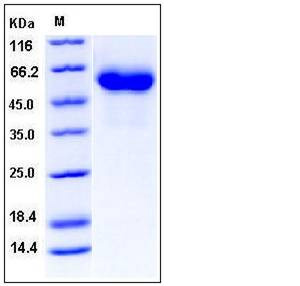Human Complement Factor H / CFH Protein (His Tag)
AHUS1,AMBP1,ARMD4,ARMS1,CFHL3,FH,FHL1,HF,HF1,HF2,HUS
- 100ug (NPP3759) Please inquiry
| Catalog Number | P10714-H08H |
|---|---|
| Organism Species | Human |
| Host | Human Cells |
| Synonyms | AHUS1,AMBP1,ARMD4,ARMS1,CFHL3,FH,FHL1,HF,HF1,HF2,HUS |
| Molecular Weight | The recombinant human CFH consists of 383 amino acids and has a calculated molecular mass of 43 kDa. The apparent molecular mass of rh CFH is approximately 55-60 kDa in SDS-PAGE under reducing conditions due to glycosylation. |
| predicted N | Ser 860 |
| SDS-PAGE |  |
| Purity | > 97 % as determined by SDS-PAGE |
| Protein Construction | A DNA sequence encoding the C-terminal segment of CFH isoform a (NP_000177.2), corresponding to amino acid (Ser 860-Arg 1231) was expressed, fused with a polyhistidine tag at the C-terminus and a signal peptide at the N-terminus. |
| Bio-activity | Measured by its ability to bind biotinylated human DMP1 in a functional ELISA. |
| Research Area | Immunology |Innate Immunity |Complement System |
| Formulation | Lyophilized from sterile PBS, pH 7.4 1. Normally 5 % - 8 % trehalose, mannitol and 0.01% Tween80 are added as protectants before lyophilization. Specific concentrations are included in the hardcopy of COA. |
| Background | Complement factor H, also known as H factor 1, and CFH, is a sialic acid containing glycoprotein that plays an integral role in the regulation of the complement-mediated immune system that is involved in microbial defense, immune complex processing, and programmed cell death. Factor H protects host cells from injury resulting from unrestrained complement activation. CFH regulates complement activation on self cells by possessing both cofactor activity for the Factor I mediated C3b cleavage, and decay accelerating activity against the alternative pathway C3 convertase, C3bBb. CFH protects self cells from complement activation but not bacteria/viruses. Due to the central role that CFH plays in the regulation of complement, there are many clinical implications arrising from aberrant CFH activity. Mutations in the Factor H gene are associated with severe and diverse diseases including the rare renal disorders hemolytic uremic syndrome (HUS) and membranoproliferative glomerulonephritis (MPGN) also termed dense deposit disease (DDD), membranoproliferative glomuleronephritis type II or dense deposit disease, as well as the more frequent retinal disease age related macular degeneration (AMD). In addition to its complement regulatory activities, factor H has multiple physiological activities and 1) acts as an extracellular matrix component, 2) binds to cellular receptors of the integrin type, and 3) interacts with a wide selection of ligands, such as the C-reactive protein, thrombospondin, bone sialoprotein, osteopontin, and heparin. |
| Reference |
